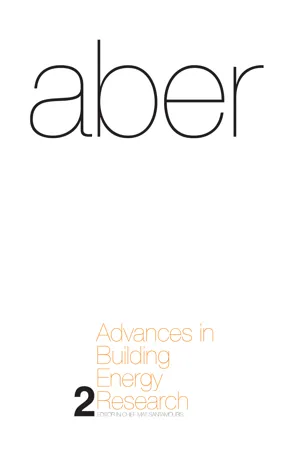
- 232 pages
- English
- ePUB (mobile friendly)
- Available on iOS & Android
Advances in Building Energy Research
About This Book
'Several high quality scientific journals are published in the area of building energy and indoor/outdoor environment; however, one has been missing. Advances in Building Energy Research fills the gap. I recommend ABER to all technical libraries, research institutes and universities. It should also be used by construction companies and those manufacturing building materials and building products.'
Professor Olli Sepp nen, President of REHVA (Federation of Heating and Air-conditioning Associations)
'Advances in Building Energy Research is a unique index. It will be an inexhaustible resource for energy related sciences and a continuous inspiration for architects around the world.'
N. Fintikakis, Architect and Director of UIA-ARES WP (Architecture and Renewable Energy Sources)
Advances in Building Energy Research (ABER) offers state-of-the-art information on the environmental science and performance of buildings, linking new technologies and methodologies with the latest research on systems, simulations and standards. As stringently reviewed as a journal but with the breadth of a book, this annual volume brings together invited contributions from the foremost international experts on energy efficiency and environmental quality of buildings. Spanning a broad range of technical subjects, this is a 'must have' reference on global developments in the field, suitable for architects and building engineers, environmental engineers, industry professionals, students, teachers and researchers in building science, technical libraries and laboratories.
Frequently asked questions
Information
1
Evolution of Cool-Roof Standards in the US
Hashem Akbari and Ronnen Levinson
Abstract
INTRODUCTION
BENEFITS OF COOL ROOFS
(A) DAVIS MEDICAL OFFICE | (B) GILR0Y MEDICAL OFFICE | (C) SAN JOSE RETAIL STORE | (D) SACRAMENTO OFFICE | (E) SACRAMENTO MUSEUM | (F) SACRAMENTO HOSPICE | |
|---|---|---|---|---|---|---|
Roof |
Table of contents
- Cover
- Half Title
- Title Page
- Copyright Page
- Table of Contents
- List of Figures and Tables
- List of Acronyms and Abbreviations
- 1 Evolution of Cool-Roof Standards in the US
- 2 A Review of Innovative Daylighting Systems
- 3 Physically Based Modelling of the Material and Gaseous Contaminant Interactions in Buildings: Models, Experimental Data and Future Developments
- 4 The Application of Urban Climate Research in the Design of Cities
- 5 Solar Air Conditioning: A Review of Technological and Market Perspectives
- 6 Experimental Methods in Ventilation
- 7 A Review of Optical Properties of Shading Devices
- Index